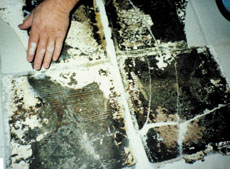
Whenever you encounter a ceramic tile problem, you need to recognize the fact that most of them are intimately related to the installation package as a whole. You need to consider not only the tile used (whether or not it is correct for the particular application) but also the underlying substrate, the bonding layers, the bonding agent, and the trowel size used.
Let's look at several problem areas in detail.
The Tile. Some ceramic tile problems occur because an incorrect tile has been used. One example would be where a glazed wall tile has been used in a shower area, which increases the likelihood of slip-and-fall accidents.
Another example would be when extremely dusty tile is used. In such cases, inadequate transfer between the tile and bonding agent ultimately results in failure. Also bear in mind that glazing cracks and body cracking of tiles may be totally unrelated to the tile itself. Instead these can be the result of environmental conditions, bonding materials or the substrate.
Another problem related to the tile is appearance - or, more specifically, the difference in tile appearance from the showroom to the room in which it is installed. A single tile in a well-lit showroom may have a significantly different appearance when installed in a different area and environment. To avoid disappointment, the tile setter should dry lay a number of tiles for the user to view. Only if the customer is satisfied with the look of the tile should you proceed with the installation.
The Substrate. In certain cases, the tile - as well as the bonding material and the workmanship - is fine. Sometimes, the problem resides in the substrate.
One example would be the use of gypsum board (white or green) in wet areas. When a leak occurs in the plumbing behind the shower wall, it will only be a matter of time before the board "dissolves" due to exposure to moisture. Another situation I've come across is where cement backerboard that has been exposed to wetness while being stored outdoors was installed and then the tile was set into organic mastic. The organic mastic becomes weakened by the wet alkali in the backerboard and installation failure results.
Caution must exercised when installing floor tile over a poured gypsum underlayment or lightweight concrete, as these substrates can be prone to failure under certain circumstances. To minimize the likelihood of problems cropping up, I suggest you use an isolation membrane or urethane adhesives. Either will alleviate the problems associated with surface moisture.
It is difficult for thinset mortars to achieve a satisfactory bond to plywood unless they are modified with latex. Even then, unless the plywood is of the proper thickness and securely fastened to eliminate flexing, failure can occur.

These conditions are usually apparent when porous, unglazed tile is used. To alleviate these conditions from the start, wait for new concrete to pass a 30-day curing period, and/or use a membrane between the concrete slab and the tile. In addition, use a latex-modified thinset mortar.
Buckled Tile. This problem may stem from expansion in the tile or from shrinkage of the concrete in the building itself. Expansion of the tile may be caused by absorption of moisture. Shrinkage of the tile bed may cause delamination due to the tension placed on the bonding material. Another possible cause of tile buckling is structural slab deflection caused by loading.
In all cases, the setting material becomes fractured because, compared to all other parts of the assembly, it has the least capacity to resist thermal, moisture or structural movement. There are also instances of buckled tile or loss of bond due to building movements caused by wind, settling or seismic stresses.
Loss of Bond. It is in this problem area that the skill of the tile setter is of paramount importance. To avoid bond-loss problems, the installer must be aware of the following conditions and techniques.
1. Proper towel size based on the tile being used.
2. Knowledge of the site conditions (i.e.: on hot days, do not spread so far that the mortar skims over and do not mix with warm or hot water.)
3. Over-sized tile requires special toweling techniques.
4. Transfer of bonding material is critical, because coverage is vitally important. Be sure to check your transfer.
Finally, I need to make brief mention of bond loss in mosaic installations. For these applications, make sure some of your bonding agent is forced upward between the tiles. Mosaic tiles are impervious and need support from the sides.



.jpg?t=1690771780)